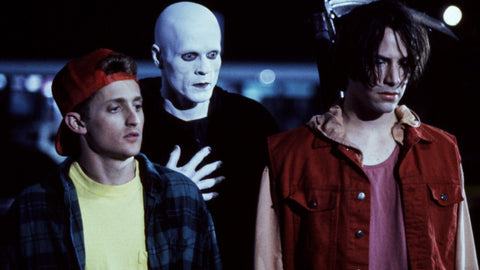
Few images are as easily recognizable and widely circulated as the Grim Reaper. The shadowy, cadaverous being who comes to pluck the souls from the deceased has become so well known, that it is instantly associated with death in any context. It has been included in countless movies, comics, and songs, but its roots go further back in time than you might expect. Through centuries of evolution, the Grim Reaper has gone from being a symbol of fleeting mortality, to a character in a stoner comedy. If the journey to how it all came to be sounds like an interesting one, look no further to find out exactly where it came from.
Before we had the scythe wielding, black robed presence that we know and love today, there were precursors in ancient mythology. Thanatos was the Greek personification of death, and would lead souls of the deceased into the underworld. In Norse mythology, the Valkyries would help guide the souls of fallen soldiers to Valhalla. Ancient religions like these would form the basis for the Angel of Death found in more contemporary theology. In the Islamic faith the Angel of Death even has a giant ledger to keep track of souls, both dead and alive, and is depicted with a scythe just like the Reaper.

The farthest that the Grim Reaper can be traced back to is 14th century England, at the peak of the Black Death. A fitting time for it to emerge, to say the least. Works of art depicting death featured the Reaper wielding all manner of weapons as an unsettling reflection of the countless lives lost to the disease at the time. Believe it or not, the scythe wasn’t originally the instrument most associated with the Reaper, but it was clearly so fitting that it has endured as one of its trademarks. Just as a farmer would ”reap” his crops with the tool, death would reap souls. Some artists also included an hourglass as a reminder that time eventually runs out for all of us, and that it will be waiting for us when it does.

Through the ages, countless stories and folk legends featuring the Reaper have been told. Many of these were famously about attempting to trick or outsmart it as a way to cheat death, always failing in the end. The Seventh Seal, a 1957 film in which a knight plays a game of chess against the Reaper for his life, is a prominent example of this. Although the embodiment of death isn't very bony in the movie, he does have a scythe and black cloak. The ghost face costume worn by the self-aware killers in the Scream franchise is also made to look like a spectral Grim Reaper, which just highlights how well Scream understands horror.


Currently, the Grim Reaper isn’t always depicted in a foreboding way. It is often used in comedy as a way to deal with morbid humor. Monty Python’s The Meaning of Life contains a scene in which death arrives at a small farmer’s hut to take his soul, but the farmer reacts as if dying were only a minor inconvenience, much to the Reaper’s chagrin. Bill and Ted’s Bogus Journey has a similar joke when the two accidentally die,but treat meeting the Grim Reaper like it’s a casual occurrence, and end up playing a game of twister with him for their lives. Even Blue Oyster Cult’s Don’t Fear the Reaper is about accepting that death is an inevitable and natural process, and something that we shouldn’t be scared of.

Since death is a constant that isn’t going anywhere any time soon, the ubiquity of the Grim Reaper lends itself to limitless ways staying intimidating, funny, or possibly even both. More than a few of our shirts feature the cloaked skeleton, both ominously and with a streak of gallows humor, if any of you are interested.



